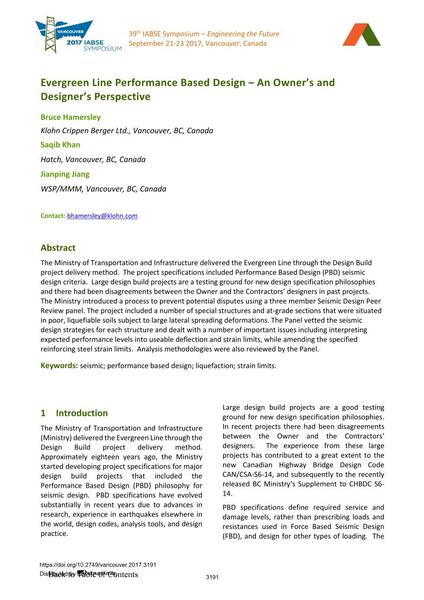Evergreen Line Performance Based Design – An Owner’s and Designer’s Perspective

|
|
|||||||||||
Détails bibliographiques
| Auteur(s): |
Bruce Hamersley
(Klohn Crippen Berger Ltd., Vancouver, BC, Canada)
Saqib Khan (Hatch, Vancouver, BC, Canada) Jianping Jiang (WSP/MMM, Vancouver, BC, Canada) |
||||
|---|---|---|---|---|---|
| Médium: | papier de conférence | ||||
| Langue(s): | anglais | ||||
| Conférence: | IABSE Symposium: Engineering the Future, Vancouver, Canada, 21-23 September 2017 | ||||
| Publié dans: | IABSE Symposium Vancouver 2017 | ||||
|
|||||
| Page(s): | 3191-3198 | ||||
| Nombre total de pages (du PDF): | 8 | ||||
| Année: | 2017 | ||||
| DOI: | 10.2749/vancouver.2017.3191 | ||||
| Abstrait: |
The Ministry of Transportation and Infrastructure delivered the Evergreen Line through the Design Build project delivery method. The project specifications included Performance Based Design (PBD) seismic design criteria. Large design build projects are a testing ground for new design specification philosophies and there had been disagreements between the Owner and the Contractors’ designers in past projects. The Ministry introduced a process to prevent potential disputes using a three member Seismic Design Peer Review panel. The project included a number of special structures and at-grade sections that were situated in poor, liquefiable soils subject to large lateral spreading deformations. The Panel vetted the seismic design strategies for each structure and dealt with a number of important issues including interpreting expected performance levels into useable deflection and strain limits, while amending the specified reinforcing steel strain limits. Analysis methodologies were also reviewed by the Panel. |
||||
